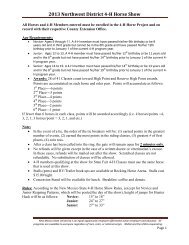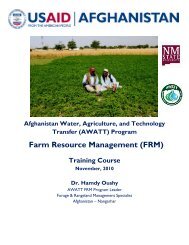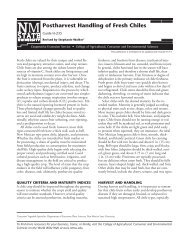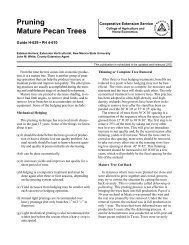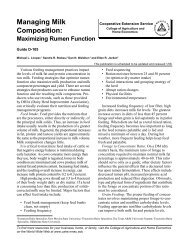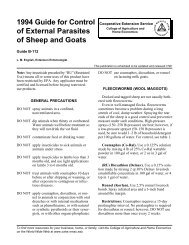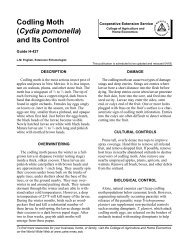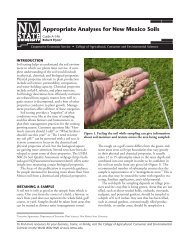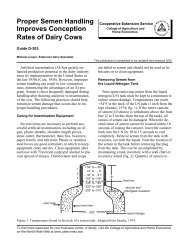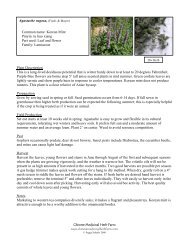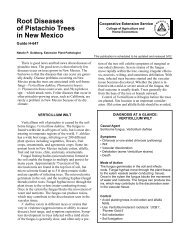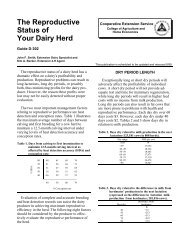A Preliminary Checklist of Plant Species for the Southern Foothills of ...
A Preliminary Checklist of Plant Species for the Southern Foothills of ...
A Preliminary Checklist of Plant Species for the Southern Foothills of ...
Create successful ePaper yourself
Turn your PDF publications into a flip-book with our unique Google optimized e-Paper software.
A <strong>Preliminary</strong> <strong>Checklist</strong><strong>of</strong> <strong>Plant</strong> <strong>Species</strong><strong>for</strong> <strong>the</strong> Sou<strong>the</strong>rn <strong>Foothills</strong><strong>of</strong> <strong>the</strong> Sacramento Mountains,Otero County, New MexicoN EW MEXU NICOSTAEI V E R SI T YTAgricultural Experiment Station • Research Report 721College <strong>of</strong> Agriculture and Home Economics
ACKNOWLEDGMENTSThe authors acknowledge financial support from <strong>the</strong>Directorate <strong>of</strong> <strong>the</strong> Environment, Natural ResourcesDivision, Ft. Bliss, TX, and U.S. Construction EngineeringResearch Laboratory, Champaign, IL.CONTENTSLocation ........................................................................1Climate .........................................................................1Soils, vegetation, and range sites .................................4Nomenclature ...............................................................4Literature cited ...........................................................11
A <strong>Preliminary</strong> <strong>Checklist</strong> <strong>of</strong> <strong>Plant</strong> <strong>Species</strong><strong>for</strong> <strong>the</strong> Sou<strong>the</strong>rn <strong>Foothills</strong> <strong>of</strong> <strong>the</strong> Sacramento Mountains,Otero County, New MexicoJoneen S. Cockman and Rex D. Pieper*A field study was conducted from June throughSeptember 1993 to inventory vegetation in and aroundephemeral drainages in <strong>the</strong> Sacramento Mountains. Theprimary purpose was to describe vegetation <strong>for</strong> ephemeraldrainages and evaluate drainage type, elevation,and position <strong>of</strong> <strong>the</strong> main channel relative to <strong>the</strong> surroundingwatershed on <strong>the</strong> vegetation. <strong>Plant</strong> foliar cover,density, and species presence were measured in severalsample locations. In <strong>the</strong> process, an extensive plantspecies list was developed <strong>for</strong> <strong>the</strong> area. It is presentedhere as a checklist <strong>of</strong> species <strong>for</strong> <strong>the</strong> sou<strong>the</strong>rn foothills<strong>of</strong> <strong>the</strong> Sacramento Mountains. It is not intended to be acomplete species list <strong>for</strong> all <strong>the</strong> foothills, but to providea basis on which botanists and plant lovers can expand.LOCATIONThe study area is located in Otero County on a portion<strong>of</strong> McGregor Range (Ft. Bliss Military Reserve) administeredby <strong>the</strong> Bureau <strong>of</strong> Land Management (BLM) as awilderness study area (fig. 1). The area is situated south<strong>of</strong> <strong>the</strong> main crest <strong>of</strong> <strong>the</strong> Sacramento Mountains in Range11 East, Township 20 South. This area borders <strong>the</strong>Lincoln National Forest on <strong>the</strong> north and is approximately16 air km nor<strong>the</strong>ast from <strong>the</strong> village <strong>of</strong> Orogrande.Elevations range from 1,200 m to 1,600 m.The study area is dissected by a large ephemeraldrainage, Culp Canyon, that flows westerly from <strong>the</strong>foothills <strong>of</strong> <strong>the</strong> Sacramento Mountains to <strong>the</strong> TularosaBasin (fig. 2). Four smaller ephemeral drainages wereselected. Two <strong>of</strong> <strong>the</strong>se (Indy and Carly) feed into CulpCanyon from headwaters on <strong>the</strong> north edge <strong>of</strong> OteroMesa. The o<strong>the</strong>r two (Alien Temple and Four Bucks)develop in Culp Canyon and flow into <strong>the</strong> TularosaBasin. The drainages are encompassed by a 12,955 ha(32,000 ac) grazing allotment administered by <strong>the</strong> BLM(fig. 2). Alien Temple and Four Bucks drainages dissecta submesa between <strong>the</strong> foothills and <strong>the</strong> Tularosa Basin.This area is desert grassland and uplands dominated bycreosotebush. Indy and Carly drainages occupy a transitionzone where blue grama (Bouteloua gracilis) isprominent on alluvial soils, and bunchgrasses and a highdiversity <strong>of</strong> shrubs occupy <strong>the</strong> uplands (fig. 2).CLIMATEMcGregor Range has a variable, semiarid climateinfluenced by moist air masses from <strong>the</strong> Gulf <strong>of</strong> Mexicoand <strong>the</strong> Pacific Ocean (BLM 1980). The annual temperatureacross McGregor Range averages 16.7°C (62° F)at lower elevation stations (BLM 1980). The growingseason extends from April to November (BLM 1980).Precipitation averages 20-25 cm annually at lowerelevations, and increases to 40+ cm in <strong>the</strong> mountainfoothills. Rain gauges were established throughoutMcGregor Range in 1971. One <strong>of</strong> <strong>the</strong>se is located in <strong>the</strong>center <strong>of</strong> <strong>the</strong> study area. The BLM recorded 38.6 cm(15.2 in) average annual rainfall at this location (from1971 to 1979). The maximum rainfall recorded <strong>for</strong> <strong>the</strong>location was 52.3 cm (20.6 in), and <strong>the</strong> minimum was28.2 cm (11.1 in). Locally, summer thunderstorms areinfluenced by <strong>the</strong> Sacramento Mountains (personal observation).Most <strong>of</strong> <strong>the</strong> precipitation occurs from July toSeptember (BLM 1980).*Research assistant and pr<strong>of</strong>essor, Department <strong>of</strong> Animal and Range Sciences
Figure 1.The study area is located in Otero County in sou<strong>the</strong>rn New Mexico on <strong>the</strong> north end <strong>of</strong> McGregor Range.2
Figure 2.The study area includes approximately 12,950 ha and is situated in a Bureau <strong>of</strong> Land Management grazingallotment. It is dissected by a large drainage, Culp Canyon, that flows westerly from <strong>the</strong> foothills <strong>of</strong> <strong>the</strong>Sacramento Mountains to <strong>the</strong> Tularosa Basin. Indy and Carly drainages (located in <strong>the</strong> foothills) feed intoCulp Canyon from headwaters on <strong>the</strong> north edge <strong>of</strong> Otero Mesa. Alien Temple and Four Bucks drainagesheadwater in Culp Canyon and flow into <strong>the</strong> Tularosa Basin. Scale: Grids represent 1.6 km x 1.6 km. Source:Bureau <strong>of</strong> Land Management grazing allotment map. Dots show <strong>the</strong> location <strong>of</strong> sample areas in upper,middle, and lower elevational zones.3
SOILS, VEGETATION, AND RANGE SITESIn general, soils <strong>of</strong> <strong>the</strong> area are well drained, calcareous,and frequently influenced by run <strong>of</strong>f from exposedbedrock, surface cobbles, and catsteps. Whole soil mappingunits are classified <strong>the</strong>rmic, but may include pockets<strong>of</strong> mesic soil.Of particular interest among soils and range sites is<strong>the</strong> overlap <strong>of</strong> Sou<strong>the</strong>rn Desert (SD-2 and) and CanadianPlains (CP-4) classifications (table 1). The drainagesare located in an ecotone that represents an importanttransition from <strong>the</strong> Tularosa Basin to <strong>the</strong> SacramentoMountains. The Sou<strong>the</strong>rn Desert range sites are influencedby an arid climate and support xeric species, most<strong>of</strong> which are warm season. The Canadian Plains rangesites are influenced by a more mesic climate and supporta mixture <strong>of</strong> warm and cool season plants.The Sou<strong>the</strong>rn Desert range sites are located on <strong>the</strong>submesa area <strong>of</strong> <strong>the</strong> study. The Canadian Plains rangesites are located in <strong>the</strong> foothills. The drainages’ vegetationcorresponds to arroyo riparian vegetation <strong>of</strong> Dick-Peddie (1993). The apache plume series is similar toportions <strong>of</strong> this study’s drainages.NOMENCLATURE<strong>Plant</strong>s were identified to <strong>the</strong> species level unlessadequate plant material was not available. Primaryreferences used to identify grasses were Allred (1993)and Hitchcock and Chase (1950). Primary referencesused to identify <strong>for</strong>bs, half-shrubs, shrubs, and treeswere Correll and Johnston (1970), Martin and Hutchins(1980), and Powell (1988). Britton and Rose (1963) wasused as <strong>the</strong> primary reference <strong>for</strong> cacti. O<strong>the</strong>r referenceswere used <strong>for</strong> vernacular names. Many species werevouchered and placed in <strong>the</strong> NMSU Range ScienceHerbarium. Vernacular names follow Soil ConservationService (1982).A total <strong>of</strong> 245 species, 153 genera, and 53 familieswere inventoried in <strong>the</strong> study area (table 2). <strong>Species</strong>richness was greater in <strong>the</strong> foothill drainages than in <strong>the</strong>submesa drainages <strong>for</strong> all species and <strong>for</strong> <strong>for</strong>bs andgrasses. The number <strong>of</strong> shrubs and trees increased wi<strong>the</strong>levation along <strong>the</strong> drainages. Families with <strong>the</strong> greatestnumber <strong>of</strong> species were <strong>the</strong> Poaceae with 47 (19.2%)and <strong>the</strong> Asteraceae with 40 (16.3%).Table 1. The study area’s soils, range sites, and soil families.Soil symbol — Name Range site Family or higher taxonLOD — Lozier-RockLoamy-skeletal, carbonatic,Outcrop 20-50% slope Limestone Hills (SD-2) <strong>the</strong>rmic Lithic CalciorthidsNTD — Nickel strong slope Gravelly (SD-2) Loamy-skeletal, mixed,<strong>the</strong>rmic Typic CalciorthidsNTD — Tencee strong slope Gravelly (SD-2) Loamy-skeletal, carbonatic,<strong>the</strong>rmic, shallow TypicPaleorthidsRRF — Rock Outcrop-Lozier20-65% slope Limestone Hills (SD-2) NoneECF — Ector-Rock Outcrop20-50% slope Limestone Hills (CP-4) Loamy-skeletal, carbonatic,<strong>the</strong>rmic Lithic Calciustolls4
Table 2. List <strong>of</strong> plant species inventoried in <strong>the</strong> study area.SCSFamily name Acronym Scientific name Vernacular nameAgavaceae AGNE4 Agave neomexicana Wooton & Standl. New Mexico agaveAnacardiaceae RHTRX* Rhus trilobata x microphylla Hybrid sumacRHTR Rhus trilobata Nutt. Large leaf sumacRHMI3 Rhus microphylla Engelm. Littleleaf sumacApocynaceae AMSA2 Amsonia longiflora Torr. Tubular slim-podAsclepiadaceae ASCLE Asclepias spp. L. MilkweedSACR3 Sarcostemma crispum benth. Climbing milk-weedAsteraceae BAAB Bahia absinthifolia Benth. Yerba ratonZIAC Zinnia acerosa (DC.) Gray Spinyleaf zinniaVIST Viguera stenoloba Blake Skeletonleaf goldeneyeVEEN Verbesina encelioides (Cav.) Benth. & Hook. ex Gray Cowpen daisyARLU Artemisia ludoviciana Nutt. Louisianna sagewortACWR5 Acourtia wrightii (Gray) Reveal & R.M. King BrownfootLEER Leucelene ericoides (Torr.) Grene Babywhite asterHAPLO2 Haplopappus spp. Cass. GoldenweedGYGL Gymnosperma glutinosum (Spreng.) Less. TatalenchoERFL Erigeron flagellaris Gray Trailing fleabaneGUSA2 Gutierezzia sarothrae (Pursh) Britton & Rusby Broom snakeweedBAPE Bahia pedata Gray Bluntscale bahiaBAPT Baccharis pteronioides DC. Yerba de pasmoTHLO Thelesperma longipes Gray GreenthreadDYTH Dyssodia thurberi (Gray) B. Rob Thurber’s dogweedLYJU Lygodesmia juncea (Pursh.) D.Don ex Hook. SkeletonplantCONYZ Conyza spp. Less. ConyzaISWR Isocoma wrightii (Gray) Rydb. JimmyweedSAAB Sanvitalia abertii Gray Abert’s domeGUMI Gutierezzia microcephala (DC.) Gray Threadleaf snakeweedMABL2 Machaeran<strong>the</strong>ra blepharyphylla (Gray) Shinners Naked goldenweedBRBR2 Brickellia brachyphylla (Gray) Gray Guadalupe brickelliaBRLA Brickellia laciniata Gray Cutleaf brickelbushBRVE Brickellia veronicaefolia Annotated by R. Turner, Austin, TX Chihuahua brickelliaMASO4 Margaranthus solanaceus Schlecht. False ground-cherryMAPI Machaeran<strong>the</strong>ra pinnatifida (Hook.) Shinners Cutleaf goldenweedHEAN2 Helianthus annuus L. Annual sunflowerHYSC2 Hymenoxys scaposa (DC.) K.Parker Clustered bitterweedPSTA Psilostrophe tagetina (Nutt.) Greene Woolly paper-flowerFLCE Flourensia cernua DC. TarbushMATA2 Machaeran<strong>the</strong>ra tanacetifolia (H.B.K.) Nees Tansyleaf spine asterHYMO Hymenoclea monogyra Torr. & Gray BurrobushMELE2 Melempodium leucanthum Torr. & Gray Rough blackfootDYAC Dyssodia acerosa DC. Prickleaf dogweedPEFE Penstemon fendleri Torr. & Gray Fenler penstemonPAIN2 Par<strong>the</strong>nium incanum H.B.K. MariolaCIUN Cirsium undulatum (Nutt.) spreng. Wavyleaf thistleCHPU4 Chrysothamnus pulchellus (Gray) Greene Southwest rabbitbush*Acronym provided is not listed in <strong>the</strong> SCS (1984) publication.5
Table 2. ContinuedSCSFamily name Acronym Scientific name Vernacular nameCRDI6 Croton dioicus Cav. New Mexico crotonEUPHO Euphorbia spp. L. SpurgeEURE4 Euphorbia revoluta Engelm. Rolled spurgeEUSE6 Euphorbia serrula Engelm. Sawtooth spurgeEUGE Euphorbia geyeri Engelm. Geyer spurgePHPO3 Phyllanthus polygonoides Nutt. ex Spreng. Leaf-flowerTRST Tragia stylaris Muell.Arg. NoseburnFabaceae PRGL2 Prosopis glandulosa Torr. Honey mesquitePESC3 Petaria scoparia Gray Camote del monteMIBO2 Mimosa borealis Gray Fragrant mimosaCABA6 Cassia bauhinioides Gray Bauhin sennaRHTE Rhyncosia texana Torr. & Gray Texas snoutbeanDAFO Dalea <strong>for</strong>mosa Torr. Fea<strong>the</strong>r daleaDAJA Dalea jamesii (Torr.) Torr. & Gray James daleaASTRAG Astragalus spp. L. LocoweedASNU4 Astragalus nuttallianus DC. Nuttall milkvetchHOJA H<strong>of</strong>fmanseggia jamesii Torr. & Gray Jame’s hog-potatoFouquieriaceae FOSP2 Fouquieria splendens Engelm. OcotilloHydrophyllaceae NAHI Nama hispidum Gray Rough poolmatPHIN2 Phacelia intermedia Wooton BluecurlsKrameriaceae KRLA Krameria lanceolata Torr. Trailing krameriaLamiaceae HEPU12 Hedeoma pulcherrimum Woon & Standl. Mock-pennyroyalSACYH Sarcostemma cynanchoides var. hartwegii Decne./(Vail) Shinners Arroyo twin-vineSALY Salvia lycioides Gray Canyon sageSADA2 Salvia davidsonii Greenm. David’s mintHEHY Hedeoma hyssopifolium Gray Sweet scentLiliaceae ALCE2 Allium cernuum Roth Nodding onionYUTO Yucca torreyi J. A. Shafer Torrey’s yuccaYUEL Yucca elata Engelm. Soaptree yuccaYUBA Yucca bacatta Torr. Banana yuccaDASYL Dasylirion spp. Zuccar. SotolNOTE Nolina texana S.Wats. Texas sacahuisteLinaceae LILE3 Linum lewisii Pursh Lewis flaxLIPU4 Linum puberulum (Engelm.) A. Heller Plains flaxMalvaceae ABWR Abutilon wrightii Gray Wright abutilonSPCO Sphaeralcea coccinea (Nutt.) Rydb. Scarlet globemallowSPSU Sphaeralcea subhastata coult. Wrinkled globemallowSPHAE Sphaeralcea ST.-Hil GloemallowMimosaceae ACCO2 Acacia constricta Benth. Mescat acaciaNyctaginaceae CYGY Cyphomeris gypsophiloides (M. Mart. & Gale.) Standl. Red cyphomerisMIOX Mirabilis oxybaphoides (Gray) Gray Oxybaphus four o’clockALIN Allionia incarnata L. Pink windmills7
Table 2. ContinuedSCSFamily name Acronym Scientific name Vernacular nameMIMU Mirabilis multiflora (Torr.) Gray Desert four o’clockMILI3 Mirabilis linearis (Pursh) Heimerl. Ribbon four o’clockOleaceae MESC Menodora scabra Gray Rough twinpodOnagraceae OEBR Oeno<strong>the</strong>ra brachycarpa Gray Longfin evening primrosePinaceae PIED Pinus edulis Engelm. Pinyon pineJUMO Juniperus monosperma (Engelm.) Sarg. One-seed juniper<strong>Plant</strong>aginaceae PLPAG <strong>Plant</strong>ago patagonica gnaphalioides Jacq./(Nutt.) Gray Woolly plaintainPoaceae LYSE* Lycurus setosus (Nutt.) C.Reeder WolftailERPU8 Erioneuron pulchellum (H.B.K.) Tateoka FluffgrassHIMU2 Hilaria mutica (Buckley) Benth. Tobosa grassERPI5 Erioneuron pilosum (Buckely) Nash Hairy tridensGCOT* Grass cotyledonARFE4 Aristida purpurea var. fendleri Nutt./Vasey Fendler’s threeawnMUEM Muhlenbergia emersleyi Vasey BullgrassMUFI Muhlenbergi filiculmis Vasey Slimstem muhlyMUHLE Muhlenbergia spp. Schreb. MuhlyMUPA2 Muhlenbergia pauciflora Buckley New Mexico muhlyMUPO2 Muhlenbergia porteri Scribn. ex W. J. Beal Bush muhlyMUPU2 Muhlenbergia pungens Thurb. Sandhill muhlyMURE Muhlenbergia repens (J.Presl.) A. Hitchc. Creeping muhlyMUSE Muhlenbergia setifolia Vasey Curlyleaf muhlyMUTO2 Muhlenbergia torreyi (Kunth) A. Hitchc. EX Bush. Ring muhlyERIN Eragrostis intermedia A. Hitchc. Plains lovegrassBOGR2 Bouteloua gracilis (H.B.K.) Lag. ex Griffiths Blue gramaBOHI2 Bouteloua hirsuta Lag. Hairy gramaBOLI2 Boerhavia linearifolia Gray Narrowleaf spiderlingENDE Enneapogon desvauxii Beauv. Spike pappusgrassELLO* Elymus longifolius (Smith) Gould Longleaf squirreltailDICA8 Digitaria cali<strong>for</strong>nica (Benth.) Henr. Arizona cottontopSTIPA1* Stipa viridula Trin. Green needlegrassSPORO Sporobolus spp. R.Br. DropseedSPGI Sporobolus giganteus Nash Giant dropseedBOBA3 Bothriochloa barbinodes (Lag.) Herter Cane bluestemPAHA Panicum hallii Vasey Hall’s panicumSPCR Sporobulus cryptandrus (Torr.) Gray Sand dropseedARIST Aristida spp. L. ThreeawnARPU9 Aristida purpurea Nutt. Purple threeawnTRNE2 Tridens nealleyi (Vasey) Wooton & Standl. Nealley tridensPENA Perezia nana Gray Desert hollyTRMU Tridens muticus (Torr.) Nash Slender tridensSPCO4 Sporobolus contractus A. Hitchc. Spike dropseedTRIDE Tridens spp. Roem. & J. A. Schultes TridensTRBE Tragus berteronianus J. A. Schultes Spike burgrassSCBR2 Scleropogon brevifolius Philippi BurrograssBOBA2 Bouteloua barbata Lag. Sixweeks gramaSELE6 Setaria leucopila (Scribn. & Merrill) K. Schum. Plains bristlegrassBOBR Bouteloua breviseta Vasey Gyp grama*Acronym provided is not listed in <strong>the</strong> SCS (1984) publication.8
Table 2. ContinuedSCSFamily name Acronym Scientific name Vernacular nameSTIPA2* Stipa viridula/robusta (Vasey) Scribn. SleepygrassBOUTE Bouteloua spp. Lag. Mut. Lag. GramaBOER4 Bouteloua eriopoda (Torr.) Torr. Black gramaBOCU Bouteloua curtipendula (Michx.) Torr. Sideoats gramaSTIPA3* Stipa robusta/eminens/tenuissima Cav./Trin. Southwestern needlegrassPolemoniaceae GIRIA Gilia rigidula var. acerosa Benth./(Gray) Wherry Needleleaf giliaPHTR Phlox triovulata Thurb. ex Torr. PhloxIPLO2 Ipomopsis longiflora (Torr.) V. Grant Paleflower giliaGIRI Gilia rigidula Benth. Spreading giliaPolygalaceae POSC2 Polygala scoparioides Chodat Small-flowered milkwortPOOB Polygala obscura Benth. Veiledseed milk-wortPOMA7 Polygala macradenia Gray Mat milkwortPOAL4 Polygala alba Nutt. White milkwortPolygonaceae ERJA Eriogonum jamesii Benth. Jame’s wild-buckwheatERHI3 Eriogonum hieracifolium Benth. Hawkweed wild-buckwheatPolypodiaceae NOCO2 Notholaena cochisensis Goodd. Cloak fernPortulacaceae TAAU Taliunum aurantiacum Engelm. Orange flameflowerPortulacaceae TAAUA Taliunum aurantiacum angustissimum Engelm./Gray Yellow flameflowerTAPU Talinum pulchellum W & Standl. Showy flameflowerPOMU2 Portulaca mundula I. Johnst. ChismaPOOL Portulaca oleracea L. Yellow-flower purslaneRanunculaceae CLDR Clematis drummondii Torr. & Gray Texas virgins-bowerRhamnaceae CEGR Ceanothus greggii Gray Desert ceanothusCOER5 Condalia ericoides (Gray) M. Johnst. JavelinabushCOWA Condalia warnockii M. Johnst. Warnock condaliaRosaceae CEMOP Cercocarpus montanus var. paucidentatus (S.Wats.) F. L. Martin Shaggy mountain mahoganyCEMOG Cercocarpus montanus var. glaber (S.Wats.) F. L. Martin Smooth mountain mahoganyFAPA Fallugia paradoxa (D.Don) Endl. Apache plumeRubiaceae HOAC Houstonia acerosa (Gray) Gray ex Benth. & Hook. Needleleaf bluetsHOACP Houstonia acerosa var. polypremoides (Gray) Terrell Needleleaf bluets1 HOPO Houstonia acerosa var. polypremoides Small Needleleaf bluetsTHTE2 Thamnosma texana (Gray) Torr. CordocilloRutaceae CHDU Choisya dumosa (Torr.) Gray Mexican orangeScrophulariaceae CALA24 Castilleja lanata Gray Woolly paintbrushCASE5 Castilleja sessiliflora Pursh Downy paintbrushCATO7 Castilleja tortifolia Pennell Twistleaf paintbrushMAAN6 Maurandya antirrhiniflora Humb. & Bonpl. ex Willd. Snapdragon maurandyaPAOB Panicum obtusum H.B.K. Vine mesquite*Acronym provided is not listed in <strong>the</strong> SCS (1984) publication.9
Table 2. ContinuedSCSFamily name Acronym Scientific name Vernacular nameSolanaceae PHHEC2 Physalis hederaefolia var. cordifolia Gray/(Gray) Waterfall Heartleaf groundcherryPHHE4 Phylas hederaefolia Gray Heartleaf groundcherrySOLAN Solanum spp. L. NightshadeSOEL Solanum eleagnifolium Cav. Elegant nightshadeCHSO Chamaesaracha sordida (Dunal) Gray Pale false-nightshadeLYAN Lycium andersonii L. Anderson’s wolfberryUlmaceae CELA Celtis laevigata var. reticulata (Torr.) Benson Sugar hackberryVerbenaceae ALWR Aloysia wrightii (Gray) A.Heller OreganilloZygophyllaceae KAHI Kallstroemia hirsutissima Vail ex Small Hairy caltropLATR Larrea tridentata (Sesse & Mocino ex DC.) Coville CreosoteO<strong>the</strong>r species observed along arroyos but not on sample locationsCyperaceae JUDE Juniperus deppeana Alligator juniperPoaceae LEDU Leptochloa dubia Green sprangletopRosaceae ROWO Rosa woodsii Wood’s roseVerbenaceae VEWR Verbena wrightii Wright’s vervainReferences Cited <strong>for</strong> IdentificationAllred, Kelly W. 1993Britton, N.L. and J.N. Rose, 1963Correll, D.S. and M.C. Johnston, 1970Hitchcock, A.S. 1950Martin, W.C. and C.R. Hutchins, 1980Powell, Michael A. 1988Soil Conservation Service, 1982Wooton, E.O. and P.C. Standley, 1972Additional References Cited <strong>for</strong> Common NamesAgilvsgi, Geyata 1984Earle, W. Hubert, 1980Fischer, Pierre C., 1989Gould, Frank W. 1981Harrington, H.D. 1964Kearney, Thomas H. and Robert K. Peebles, 1960Niehaus, Theodore F., et al. 1984Vines, Robert A. 1986Warnock, Barton H. 1970Warnock, Barton H. 1974Warnock, Barton H. 197710
LITERATURE CITEDAgilvsgi, G. 1984. Wildflowers <strong>of</strong> Texas. Shearer Publishing,Fredericksburg, TX.Allred, K. W. 1993. A Field Guide to <strong>the</strong> Grasses <strong>of</strong> NewMexico. Agr. Exp. Sta., New Mex. State Univ, LasCruces, NM.Britton, N. L. and J. N. Rose, 1963. The Cactaceae(Descriptions and Illustrations <strong>of</strong> <strong>Plant</strong>s <strong>of</strong> <strong>the</strong> CactusFamily, Vol. I-IV). Dover Pub. Inc. NY.Bureau <strong>of</strong> Land Management. 1980. Draft EnvironmentalImpact Statement: Grazing Management,McGregor EIS Area, New Mexico. USDI Bureau <strong>of</strong>Land Management, Las Cruces, NM.Correll, D. S. and M. C. Johnston. 1970. Manual <strong>of</strong> <strong>the</strong>Vascular <strong>Plant</strong>s <strong>of</strong> Texas. Texas Research Foundation.Renner, TX.Earle, W. H. 1980. Cacti <strong>of</strong> <strong>the</strong> Southwest. RanchoArroyo Book Distributor. Tempe, AZ.Fischer, P. C. 1989. 70 Common Cacti <strong>of</strong> <strong>the</strong> Southwest.Southwest Parks and Monuments Association. Tucson,AZ.Gould, F. W. 1981. Grasses <strong>of</strong> Southwestern UnitedStates. Univ. Arizona Press. Tucson, AZ.Harrington, H. D. 1964. Manual <strong>of</strong> <strong>the</strong> <strong>Plant</strong>s <strong>of</strong> Colorado.Sage Books. The Shallow Press Inc., Chicago,IL.Hitchcock, A. S. 1950. Manual <strong>of</strong> <strong>the</strong> Grasses <strong>of</strong> <strong>the</strong>United States. USDA Misc. Pub. No. 200. Secondedition revised by Agnes Chase. U.S. Govt. PrintingOffice, Washington.Kearney, T. H. and R. K. Peebles. 1960. Arizona Flora.Univ. Cali<strong>for</strong>nia Press. Berkeley, CA.Martin, W. C. and C. R. Hutchins, 1980. A Flora <strong>of</strong> NewMexico. J. Cramer, Pub. Vaduz, West Germany.Niehaus, T. F., C. L. Ripper, and V. Sauage. 1984. ThePeterson Field Guide Series: A Field Guide to Southwesternand Texas Wildflowers. Houghton MifflinCo., Boston, MA.Powell, M. A. 1988. Trees and Shrubs <strong>of</strong> Trans-PecosTexas (Including Big Bend and Guadalupe MountainsNational Parks). Big Bend Natural HistoryAssoc., Inc.Soil Conservation Service. 1981. Soil Survey <strong>of</strong> OteroArea, New Mexico. USDA SCS CN A57.38:OT2-2.U.S. Govt. Printing Office, Washington D.C.Soil Conservation Service. 1982. National List <strong>of</strong> Scientific<strong>Plant</strong> Names, Volume 1 - List <strong>of</strong> <strong>Plant</strong> Names,Volume 2 - Synonymy. USDA Soil ConservationService SCS-TP-159.Vines, R. A. 1986. Trees, Shrubs, and Woody Vines <strong>of</strong><strong>the</strong> Southwest (A guide <strong>for</strong> <strong>the</strong> states <strong>of</strong> Arkansas,Louisiana, New Mexico, Oklahoma, and Texas).Univ. Texas Press, Austin, TX.Warnock, B. H. 1970. Wildflowers <strong>of</strong> <strong>the</strong> Big BendCountry, Texas. Sul Ross State University. Alpine,TX.Warnock, B. H. 1974. Wildflowers <strong>of</strong> <strong>the</strong> GuadalupeMountains and <strong>the</strong> Sand Dune Country, Texas. SulRoss State University. Alpine, TX.Warnock, B. H. 1977. Wildflowers <strong>of</strong> <strong>the</strong> Davis Mountainsand Marathon Basin Texas. Sul Ross StateUniversity. Alpine, TX.Wooton, E. O. and P. C. Standley. 1972. Flora <strong>of</strong> NewMexico. J. Cramer Ed. Printed in Germany by Strauss& Cramer GmbH. 6901 Leutershausen. (OriginallyUnited States National Herbarium Vol. 19. Govt.Printing Office Washington D.C. 1915.)11
New Mexico State University is an affirmative action/equal opportunity employer and educator. NMSU and <strong>the</strong> U.S. Department <strong>of</strong> Agriculturecooperating.May 1997Las Cruces, NM5C



